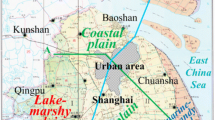Abstract
Singapore marine clay at Changi is a quartenary deposit that lies within valleys cut in the Old Alluvium. It is locally known as Kallang formation. The pre-reclamation site characterization and laboratory testing was carried out by conducting marine sampling boreholes, in situ dissipation tests and field vane test. In situ dissipation tests were conducted with the piezocone, flat dilatometer, self-boring pressuremeter and BAT permeameter. The purpose of the site characterization was to determine the consolidation characteristics, strength characteristics, stratigraphy, and mineralogy of Singapore marine clay. The consolidation properties of marine clay are required prior to land reclamation activities in order to predict the magnitude and rates of settlement with the expected fill load and future service load as well as for the design of soil improvement works. The shear strength properties are required for slope stability analyses during reclamation and for the stability analyses of shore protection works. Clay mineralogy tests and photographic identification of the marine clay was carried out to determine the mineralogical properties and to visually record the marine clay colour and texture.









Similar content being viewed by others
Abbreviations
- Cc :
-
Compression index
- c h :
-
Coefficient of consolidation due to horizontal flow
- c kv :
-
Vertical hydraulic conductivity change index
- Cc :
-
Recompression index
- c u :
-
Undrained shear strength
- c v :
-
Coefficient of consolidation due to vertical flow
- Cα :
-
Secondary compression index
- eo :
-
Initial void ratio
- Gs :
-
Specific gravity
- k h :
-
Horizontal hydraulic conductivity
- k v :
-
Vertical hydraulic conductivity
- m v :
-
Coefficient of volume compressibility
- OCR:
-
Overconsolidation ratio
- S t :
-
Degree of sensitivity of marine clay
- z:
-
Depth below seabed in meters
- γbulk :
-
Bulk density
- γw :
-
Unit weight of water
- σ′vo :
-
Vertical effective stress
References
Arulrajah A, Nikraz H, Bo MW (2004) In situ testing of Singapore Marine Clay at Changi. Geotech Geol Eng 23(2):111–130
Arulrajah A, Nikraz H, Bo MW (2006a) In situ pore water pressure dissipation testing of marine clay under reclamation fills. Geotech Geol Eng 24:29–43
Arulrajah A, Nikraz H, Bo MW (2006b) Assessment of marine clay improvement under reclamation fills by in situ testing methods. Geotech Geol Eng 24:219–226
Bo Myint Win, Arulrajah A, Choa V (1998) Hydraulic conductivity of Singapore marine clay. Q J Eng Geol 31(4):291–299
Bo Myint Win, Chang MF, Arulrajah A, Choa V (2000) Undrained shear strength of the Singapore marine clay at Changi from in situ tests. Geotech Eng J Southeast Asian Geotech Soc 31(2):91–107
Bo MW, Chu J, Low BK, Choa V (2003a) Soil improvement—Prefabricated vertical drain techniques. Thomson Learning, Singapore 068808
Bo MW, Choa V, Hong KH (2003b) Material characteristic of Singapore marine clay at Changi. Q J Eng Geol Hydroge 36(4):305–321
Choa V, Bo MW, Chu J (2001) Soil Improvement Works for the Changi East Reclamation Project. Ground Improv 5(4):141–153
Chu J, Bo MW, Chang MF, Choa V (2002) Consolidation and permeability properties of Singapore marine clay. J Geotech Geoenviron Eng ASCE 128(9):724–732
Flaate K (1966) Factors influencing the results of vane tests. Can Geotech J 3(1):18–31
Larsson R (1981) Drained behaviour of Swedish clays. Swedish Geotechnical Institute, Report No. 12, Sweden
Leroueil S, Lerat P, Hight DW, Powell JJM (1992) Hydraulic conductivity of a recent estuarine silty clay at Bothkennar. Geotechnique 42:275–288
Norwegian Geotechnical Society (1979) Recommended procedures for vane borings. August, Norway
Public Works Department Singapore (PWD) (1976) The geology of Singapore. Publication by the Public Works Department, Singapore
Rowe RW, Barden L (1966) A new consolidation cell. Geotechnique 26(2):162–170
Tavenas F, Leblond P, Jean P, Leroueil S (1983) The permeability of natural clays. Part 1: methods of laboratory measurement. Can Geotech J 20:629–644
Taylor DW (1948) Fundamentals of soil mechanics. Wiley, New York
Yong KY, Karunaratne GP, Lee SL (1990) Recent developments in soft clay engineering in Singapore. Kansai International Geotech Forum ‘90, Osaka, Japan, pp 1–8
Acknowledgement
The authors would like to thank Dr. A. Vijiaratnam the Former Chairman of SPECS Consultants (Singapore) Pte. Ltd. for his support in the submission of these research findings.
Author information
Authors and Affiliations
Corresponding author
Rights and permissions
About this article
Cite this article
Arulrajah, A., Bo, M.W. Characteristics of Singapore Marine Clay at Changi. Geotech Geol Eng 26, 431–441 (2008). https://doi.org/10.1007/s10706-008-9179-2
Received:
Accepted:
Published:
Issue Date:
DOI: https://doi.org/10.1007/s10706-008-9179-2




